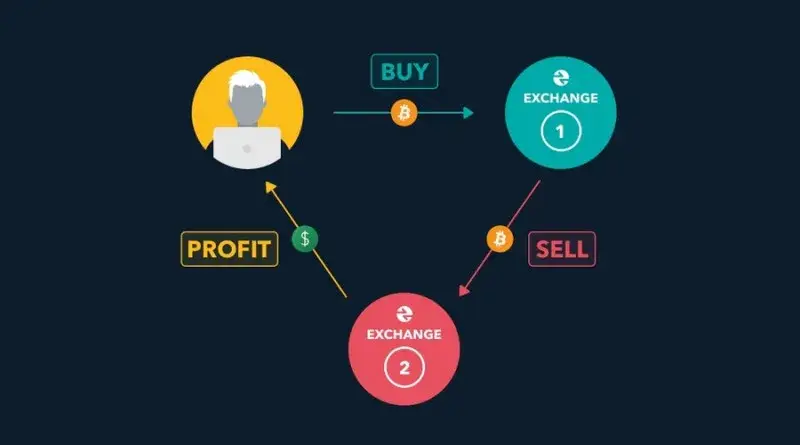Cryptocurrency arbitrage is like playing with fire: incredibly tempting, but it can also burn you. Many investors see an opportunity to buy assets on one exchange at a low price and sell them on another exchange where the price is higher. They start thinking that they have found a quick way to get rich. But the reality, as is so often the case, is much more complicated.
The risks of cryptocurrency arbitrage include not only unexpected price movements but also hidden fees that can eat into your profits. Market volatility plays a role, especially on smaller platforms, where even small price fluctuations can lead to losses. Before we dive into this process, it is important to understand that to get rich quickly, you not only need to be able to make money, but also to avoid potential losses. It is also important to choose the right platforms for arbitrage trading.

What are the risks of cryptocurrency arbitrage, and how do they affect profits?
In the crypto market, arbitrage seems like an attractive process at first glance. It is based on a simple principle: buy assets at a low price on one exchange and sell them at a higher price on another. But not everything is as simple as it seems at first glance. The risks of cryptocurrency arbitrage can significantly affect profits.
Volatility: One of the most powerful determinants of risk
The impact of volatility on arbitrage should not be underestimated. One wrong move and the whole operation can go wrong. In the crypto market, volatility means that prices can change quickly, which has a major impact on transactions.
For example, Binance and Kraken often see price increases of 2-3% in just a few minutes, especially when it comes to less liquid coins. Such a change can have a significant impact on the arbitrage transaction. Even if you have estimated the potential profit in advance, these fluctuations can still cause your investment to fail. If you manage to close the deal before the price changes, that’s good. If you don’t, you lose money.
Hidden costs and fees: risks that can make crypto arbitrage unprofitable
Be careful with the costs when you make transactions on the platforms. They can have a big impact on the profit. For example, you will not only have to deal with the basic costs, but also with additional costs for withdrawals, currency exchanges and even if your account is inactive. Hidden costs, such as spreads (the difference between the buy and sell price), are often significant.
Suppose you find an arbitrage opportunity where the price difference is 2%, but the costs on both exchanges are 1% and another 0.5% for transferring money between the exchanges. As a result, the actual profit will be only 0.5%. To do this, it is necessary to carefully consider all expenses and compare them with the expected profitability.
Slipping: How it can become a trap
 What is slippage in arbitrage? This is a situation where the expected price of a trade deviates from the actual price. Imagine you place an order to buy cryptocurrency at $500 per coin. By the time you execute the order, the price has already risen to $505. This “run” on the exchange rate is a drop that can wipe out your profits.
What is slippage in arbitrage? This is a situation where the expected price of a trade deviates from the actual price. Imagine you place an order to buy cryptocurrency at $500 per coin. By the time you execute the order, the price has already risen to $505. This “run” on the exchange rate is a drop that can wipe out your profits.
Slippage occurs when the market is too volatile or liquidity in the stock market is very low. Slippage can therefore become a real problem in arbitrage trades on less popular cryptocurrency platforms, where orders are not executed immediately. In high volatility, even a difference of a few tens of dollars can significantly affect the outcome.
Risk mitigation strategies in cryptocurrency arbitrage
Understanding the risks is the first step, but to be successful in cryptocurrency arbitrage, it is important to implement strategies to minimize the risks. How can the chance of loss be reduced? Let’s look at some proven methods.
Use multiple exchanges and automate processes
One of the most effective strategies is to use multiple platforms to perform arbitrage operations. This allows you to minimize losses associated with volatility on a platform and spread the risks. However, working with multiple exchanges manually is extremely cumbersome, especially when it comes to fast transactions. That is why it is important to use automated trading.
Bots and programmable algorithms can significantly improve efficiency by automating arbitrage processes and reducing the chance of errors. They react quickly to price changes and automate transactions with minimal delays, thus avoiding losses due to slippage.
Monitor market volatility and liquidity
How can we minimize the risks of volatility in cryptocurrency arbitrage? You can achieve this by closely monitoring liquidity in different markets and planning in advance when to trade. Ideally, transactions should be executed during periods of low volatility, when exchange rates are stable and demand is high.
In addition, it is necessary to monitor market spreads and avoid arbitrage opportunities on less liquid platforms where slippage is more likely.
How to minimize the risks of cryptocurrency arbitrage given current trends
Technology continues to evolve and new tools make it possible to minimize risks in cryptocurrency arbitrage. For example, it has become popular among traders to use artificial intelligence to analyze the market and predict price movements.
AI algorithms can follow trends and take into account many factors: news, liquidity, volatility and even the behavior of other participants. These systems analyze and optimize arbitrage operations in real time, minimizing risks and improving results. Here are some useful tools:
News monitoring. Track events that affect cryptocurrency prices to predict dynamics in advance.
Algorithmic trading systems. Transaction automation reduces the human factor and allows you to react quickly to changes.
Volatility forecasting. Statistical models help predict large price swings.

How to effectively manage cryptocurrency arbitrage risks and protect your capital
 To successfully trade in cryptocurrency arbitrage, it is necessary to consider all risks and implement strategies to minimize them. Constantly analyze the market, choose the right exchanges, and use automation tools. This will not only protect your capital, but also provide stable profits.
To successfully trade in cryptocurrency arbitrage, it is necessary to consider all risks and implement strategies to minimize them. Constantly analyze the market, choose the right exchanges, and use automation tools. This will not only protect your capital, but also provide stable profits.
 en
en  ru
ru  de
de  ar
ar  es
es  nl
nl  hi
hi  fr
fr  it
it  pt
pt  el
el 











